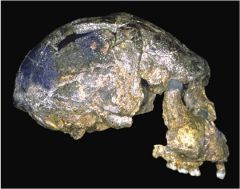![]()
![]()
![]()
Use LEFT and RIGHT arrow keys to navigate between flashcards;
Use UP and DOWN arrow keys to flip the card;
H to show hint;
A reads text to speech;
26 Cards in this Set
- Front
- Back
|
This early researcher’s scientific approach to the origin of humans, searching for fossils to test his hypothesis rather than comparative animal anatomy, helped create the discipline of paleoanthropology.
|
Dubois |
|
|
Homo habilis differs from earlier australopithecines because it
|
had a larger brain
|
|
|
The first hominin species to disperse from Africa, where it originated, was
|
H. erectus
|
|
|
H. erectus’s change in limb proportions, to a body with short arms and long legs, indicates
|
fully modern bipedal locomotion
|
|
|
Fossils of H. erectus have been found at which of these sites in Ethiopia?
|
All of these are correct
|
|
|
The rapid spread of H. erectus out of Africa can be attributed in part to
|
material culture and tool use
|
|
|
Evidence of fire use at Wonderwerk Cave included
|
All of these are correct |
|
|
The main reason that H. erectus increased in stature and body size over H. habilis is
|
access to animal protein
|
|
|
Evidence of tool use in H. habilis includes
|
All of these are correct |
|
|
It is possible that australopithecines went extinct and Homo flourished because of
|
habitat changes
|
|
|
A H. erectus specimen from Turkey dating to about 500,000 yBP demonstrates the antiquity of _______________, a disease still prevalent today
|
tuberculosis
|
|
|
__________ H. erectus were more robust than ___________ H. erectus
|
African; Asian |
|
|
H. erectus’s brain increased about ________ compared to H. habilis’s.
|
30%
|
|
|
If a fully clothed Nariokotome boy were walking down the streets of New York City, which feature would indicate that he was NOT a modern human
|
None of these is correct.
|
|
|
H. erectus was originally known as
|
All of these are correct
|
|
|
Your roommate, a staunch vegetarian, argues that eating meat is unhealthy. You counter this argument by noting that the latest research in paleoanthropology suggests that
|
we might not be the tall, big-brained humans we are today had our hominin ancestors not eaten meat
|
|
|
You come across a website that states Homo rudolfensis was a slightly larger version of Homo habilis found in Canada in the eighteenth century. Based on your knowledge of physical anthropology, though, you know that this website is bunk because
|
All of these are correct |
|
|
Paleoanthropologists have found stone tool marks on Homo erectus bones, and this bit of information has been spun on TV as "cannibal hominins." A valid criticism of this sensationalistic conclusion is that
|
the tool marks only indicate that flesh was removed, not whether it was consumed
|
|
|
If you wanted to know what the landscape was like when Homo erectus walked Earth a million years ago, you might try to find evidence by studying
|
All of these are correct
|
|
|
Paleoanthropologists know that Acheulian hand axes were used to butcher animals because
|
the wear patterns on ancient tools are similar to those that can be replicated experimentally
|
|
|
An evolutionary argument for why women today need assistance in giving birth may be that
|
the large brains of Homo sapiens infants necessitate a different pattern of childbirth events than seen in earlier hominins and primates
|
|
|
During excavations at this site in China, researchers found the fossil remains of over 40 hominins
|
Zhoukoudian |
|
|
These stone tools made by H. erectus belong to the ___________ tool complex
|
Acheulian
|
|

This skull shows some of the characteristics of H. erectus, including a long cranium, low forehead, large brow ridges, and
|
a sagittal keel
|
|

An animal bone such as this one may provide evidence that Homo erectus scavenged for meat if
|
puncture holes from carnivore teeth are found beneath cuts made by manufactured tools |
|

During a lab session in your physical anthropology class, you are asked to look at this tooth under magnification and state the importance of its morphology. A valid answer would be
|
the ridges on the enamel can be used to figure out how quickly the tooth formed
|

